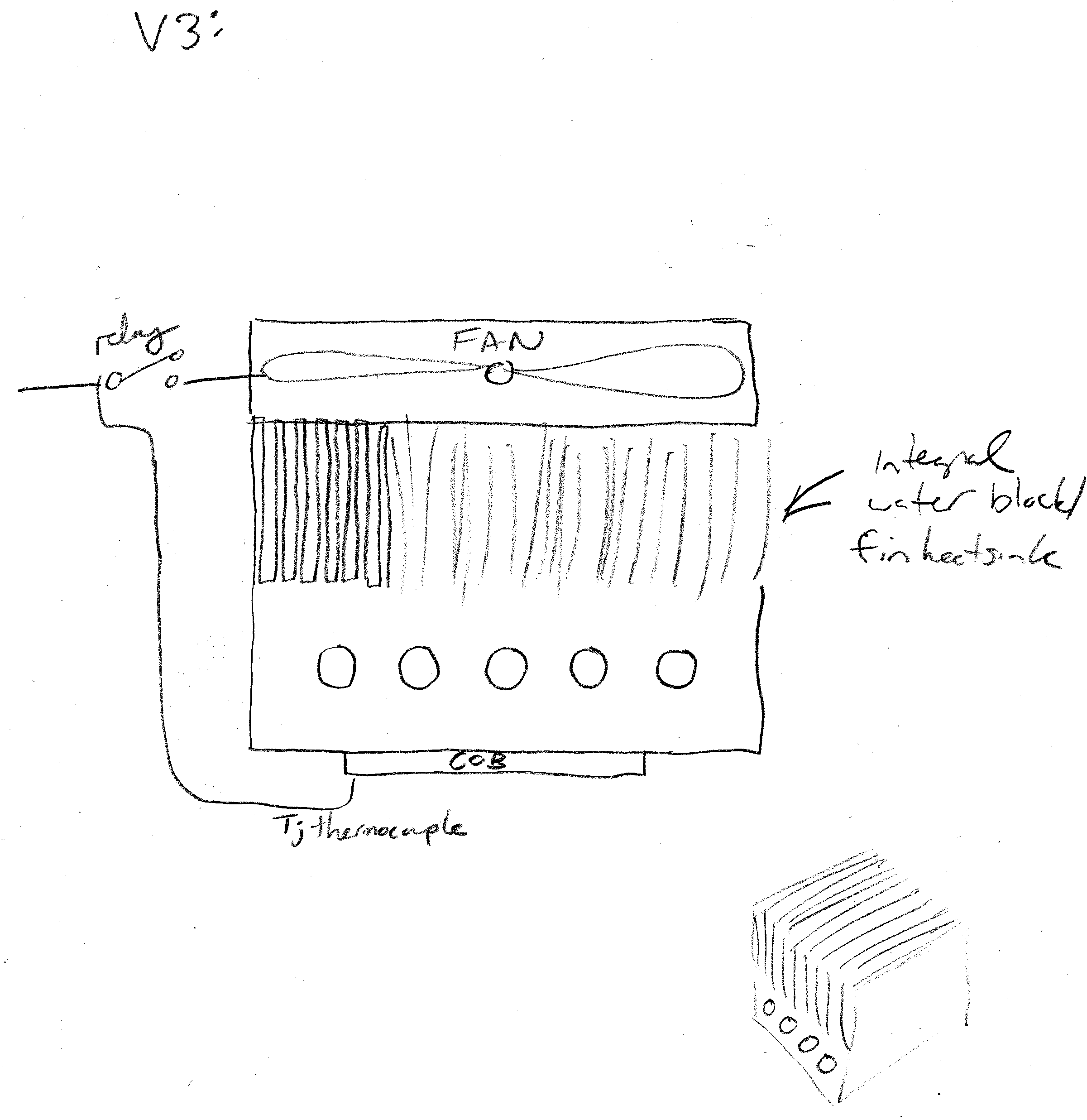Growmau5
Well-Known Member
Hey Guys, a couple of commenters on YT dropped me a link to a guy prototyping an LED fixture platform that will allow the user to choose
-standard active cooling
-inline ducted cooling
-<or> water cooling via a copper manifold that integrates with the heatsinks
I figured I would start a thread about it and maybe we could have a positive discussion about the possibilities of this kind of platform. When a new company comes around here, they typically get bashed about price, efficacy, etc etc. I asked this guy a few questions on YouTube about the light engine, here are some of the para phrased responses:
What is the light engine comprised of?
For the LED modules I use Luxeon Rebel: http://www.lumileds.com/products/color-leds/luxeon-rebel-color , Luxeon Z: http://www.lumileds.com/products/high-power-leds/luxeon-z , Luxeon Z ES: http://www.lumileds.com/products/high-power-leds/luxeon-z-es and Luxeon Z UV: http://www.lumileds.com/products/uv-leds/luxeon-z-uv (in some setups) They are arranged in modules of 9, 12 or 16 per light. The light is focused into a tighter beam with an acrylic secondary lens array (60 degree). You can see some additional specs & measurements in the description here: https://chilledgrowlights.com/shop/diy-led-grow-light-modules/diy-led-grow-light-engine-assembly
Thank you so much for the response, very few led companies are willing to be this transparent about their diode selection. As you get closer to production, could we see a revision to the light engine in favor of a newer diode with a more impressive luminous efficacy like nichia, osram reds or samsung whites
You're welcome! That's something I hated myself, so from the get go am doing exactly the opposite No secrets. From my testing this is the most efficient setup I have found and I have tested my light against many others. For the time being the chips will be as designed. BTW, I use a spectroradiometer with integrating sphere to do the measurements of the LED chips. Perhaps down the road when something proves to be better then I'll switch to using those. One thing to keep in mind, it's not just the output efficiency of the LED chip, its also how well it would integrate with a secondary optic and how much of total rays will make it through to the final target - when this is considered as a whole, so far nothing beats my choices.
No secrets. From my testing this is the most efficient setup I have found and I have tested my light against many others. For the time being the chips will be as designed. BTW, I use a spectroradiometer with integrating sphere to do the measurements of the LED chips. Perhaps down the road when something proves to be better then I'll switch to using those. One thing to keep in mind, it's not just the output efficiency of the LED chip, its also how well it would integrate with a secondary optic and how much of total rays will make it through to the final target - when this is considered as a whole, so far nothing beats my choices.
Competitors in the medium to higher end LED grow light market are hitting 2.2 µmol/J today, and possibly 2.4 µmol/J by the end of 2016. Do you see your product being in this ballpark once released.
Yup, definitely in line with those numbers.
No hard pricing data or availability yet, but I think it is a very interesting and well designed product. The data sheets on his diode choices aren't incredibly impressive, but if the guy has access to an integrated sphere and spectroradiometer, he clearly has the data to back up his choices...
His YouTube (very nice basement room): https://www.youtube.com/channel/UCJHRHD4xQYZb84ltXXb-tWw
video of the internals of the LED product:
-standard active cooling
-inline ducted cooling
-<or> water cooling via a copper manifold that integrates with the heatsinks
I figured I would start a thread about it and maybe we could have a positive discussion about the possibilities of this kind of platform. When a new company comes around here, they typically get bashed about price, efficacy, etc etc. I asked this guy a few questions on YouTube about the light engine, here are some of the para phrased responses:
What is the light engine comprised of?
For the LED modules I use Luxeon Rebel: http://www.lumileds.com/products/color-leds/luxeon-rebel-color , Luxeon Z: http://www.lumileds.com/products/high-power-leds/luxeon-z , Luxeon Z ES: http://www.lumileds.com/products/high-power-leds/luxeon-z-es and Luxeon Z UV: http://www.lumileds.com/products/uv-leds/luxeon-z-uv (in some setups) They are arranged in modules of 9, 12 or 16 per light. The light is focused into a tighter beam with an acrylic secondary lens array (60 degree). You can see some additional specs & measurements in the description here: https://chilledgrowlights.com/shop/diy-led-grow-light-modules/diy-led-grow-light-engine-assembly
Thank you so much for the response, very few led companies are willing to be this transparent about their diode selection. As you get closer to production, could we see a revision to the light engine in favor of a newer diode with a more impressive luminous efficacy like nichia, osram reds or samsung whites
You're welcome! That's something I hated myself, so from the get go am doing exactly the opposite
Competitors in the medium to higher end LED grow light market are hitting 2.2 µmol/J today, and possibly 2.4 µmol/J by the end of 2016. Do you see your product being in this ballpark once released.
Yup, definitely in line with those numbers.
No hard pricing data or availability yet, but I think it is a very interesting and well designed product. The data sheets on his diode choices aren't incredibly impressive, but if the guy has access to an integrated sphere and spectroradiometer, he clearly has the data to back up his choices...
His YouTube (very nice basement room): https://www.youtube.com/channel/UCJHRHD4xQYZb84ltXXb-tWw
video of the internals of the LED product:






